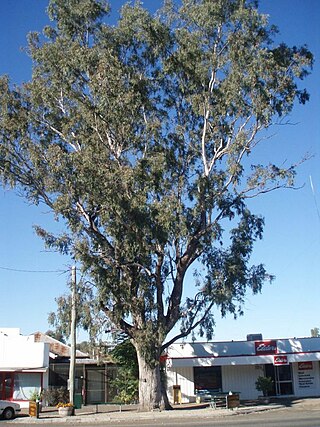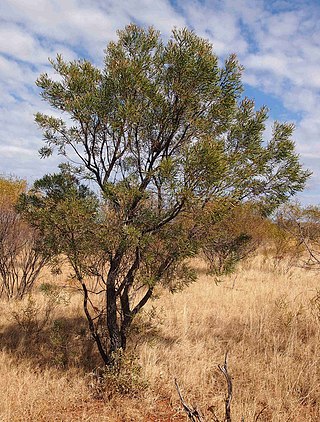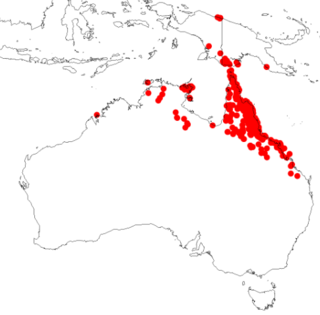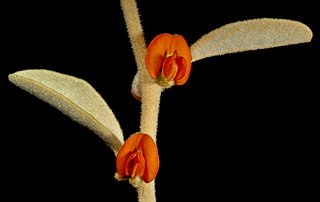
Eucalyptus miniata, commonly known as the Darwin woollybutt or woolewoorrng, is a species of medium-sized to tall tree that is endemic to northern Australia. It has rough, fibrous, brownish bark on the trunk, smooth greyish bark above. Adult leaves are lance-shaped, the flower buds are ribbed and arranged in groups of seven, the flowers orange or scarlet and the fruit is cylindrical to barrel-shaped or urn-shaped, with ribs along the sides.

Eucalyptus microtheca, commonly known as the coolibah, is a species of tree that is endemic to northern Australia. It has rough, flaky or fibrous bark on the trunk and branches, lance-shaped adult leaves, flower buds in groups of seven, white flowers and spherical to conical fruit. It is widely distributed from the Kimberley region of Western Australia to Cape York in Queensland.

Corymbia ptychocarpa, commonly known as swamp bloodwood or spring bloodwood, is a species of tree that is endemic to northwestern Australia. It has rough bark on the trunk and branches, broadly lance-shaped adult leaves, flower buds in groups of seven, creamy yellow, pink or red flowers, and barrel-shaped, ribbed fruit.

Micromelum minutum, commonly known as limeberry, dilminyin. kimiar margibur, tulibas tilos (Philippines), sesi (Indonesia) and samui (Thailand), is a species of small tree or shrub in the citrus plant family Rutaceae. It occurs from India and Indochina to Australia. It has pinnate leaves with egg-shaped to lance-shaped leaflets, hairy, pale green or creamish, scented flowers arranged in large groups and yellow to orange or red, oval to spherical berries in dense clusters.

Acacia adoxa, commonly known as the grey-whorled wattle, is a species of plant in the legume family that is native to northern Australia.

Haemodorum brevicaule is a perennial herb from 0.025 to 0.3 m tall, in the bloodroot family, the Haemodoraceae, native to northern Australia. It has deep-red to purplish-black flowers which are seen from September to December, and it grows on red clay and basalt.

Ficus coronulata, commonly known as the peach-leaf fig, and in the Northern Territory as river fig and crown fig, is one of several fig species commonly known as sandpaper figs. It is native to Western Australia and the Northern Territory.

Eucalyptus pruinosa, commonly known as silver box, silver leaf box, apple box or smoke tree, is a species of tree or a mallee that is endemic to northern Australia. The Jaminjung peoples know the tree as yarrirra or jarnbiny, the Jaru as wararn and the Wagiman as wararn. It has rough, fibrous to flaky bark on the trunk and branches, a crown composed of juvenile, glaucous, heart-shaped to broadly elliptical leaves arranged in opposite pairs, flower buds arranged in groups of seven on the ends of branches, creamy white to pale yellow flowers and cylindrical to conical fruit.

Acacia ancistrocarpa, commonly known as fitzroy wattle, is a shrub belonging to the genus Acacia and the subgenus Juliflorae. The shrub is also known as fish hook wattle, pindan wattle and shiny leaved wattle.

Hakea arborescens, commonly known as the common hakea or the yellow hakea, is a shrub or tree of the genus Hakea native to parts of northern Australia.

Xanthostemon paradoxus, commonly known as bridal tree or northern penda, is a shrub or tree species in the family Myrtaceae that is endemic to Australia.

Stackhousia clementii is a species of plant in the family Celastraceae and is native to Australia.

Acacia simsii is a shrub belonging to the genus Acacia in the family Fabaceae. It is native to New Guinea and northern Australia. In Australia it is found in both the Northern Territory and Queensland.

Scaevola basedowii is an erect multi-stemmed shrub in the family Goodeniaceae, endemic to Western Australia, the Northern Territory and South Australia.

Scaevola browniana is a shrub in the family Goodeniaceae, endemic to Western Australia, the Northern Territory and Queensland.

Pityrodia ternifolia is a species of flowering plant in the mint family, Lamiaceae and is endemic to north-western Australia. It is an erect shrub with densely hairy stems, sticky and prickly, egg-shaped leaves, and mauve or pinkish-red, tube-shaped flowers.

Sida spenceriana is a small plant in the family Malvaceae found in Queensland, the Northern Territory and Western Australia
Polygala bifoliata is a species of flowering plant in the milkwort family (Polygalaceae), which was first described in 2012 by Raelee Kerrigan. It is endemic to the Northern Territory and Western Australia.

Tephrosia arenicola is a plant in the Fabaceae family, native to the north of Western Australia. The species has no synonyms.
Hibbertia echiifolia is a species of flowering plant in the family Dilleniaceae and is endemic to northern Australia. It is a variable shrub with elliptic to lance-shaped or oblong leaves and yellow flowers arranged singly in leaf axils, with twenty-nine to forty-five stamens arranged around the three carpels.




















